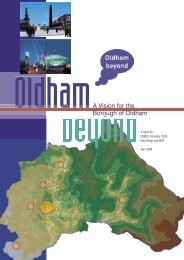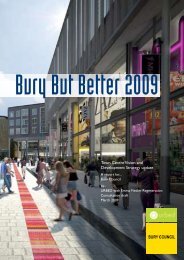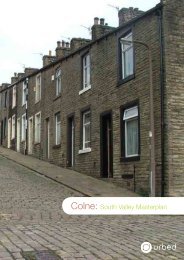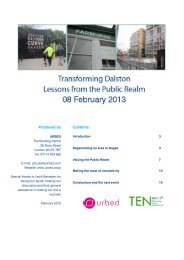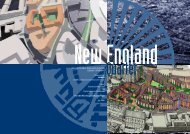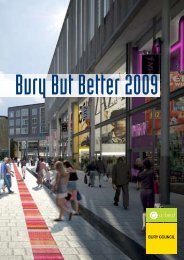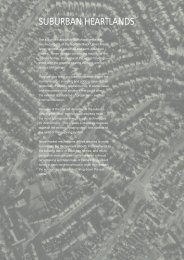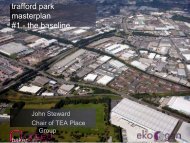Beyond Eco-towns Applying the Lessons from Europe - Urbed
Beyond Eco-towns Applying the Lessons from Europe - Urbed
Beyond Eco-towns Applying the Lessons from Europe - Urbed
You also want an ePaper? Increase the reach of your titles
YUMPU automatically turns print PDFs into web optimized ePapers that Google loves.
1<br />
2<br />
3<br />
Nieuwland, Amersfoort - all <strong>the</strong> case<br />
studies used local features in <strong>the</strong><br />
landscape and a variety of building design<br />
to create unique and distinctive character<br />
Kronsberg - 3000 new homes within a<br />
comprehensive civic plan for landscape<br />
design, social amenity and low energy. The<br />
Local Authority established <strong>the</strong> land value,<br />
and developers were chosen on merit<br />
Hammarby - by retaining more control of<br />
land value and design standards not only<br />
are <strong>the</strong> buildings, but also <strong>the</strong> public realm<br />
of exemplary quality<br />
4 Hammarby - why is it that <strong>the</strong> Greenwich<br />
Millennium Village delivered 600 homes in<br />
<strong>the</strong> space of 6 years, while Hammarby built<br />
this number in one year?<br />
1<br />
2<br />
capacity through multi-disciplinary teams, local development agencies, and in some cases, public private<br />
partnerships with private development companies (hence avoiding unrealistic standards and disputes).<br />
HafenCity and Kronsberg show that it is possible for <strong>the</strong> local authority to set exacting standards for new<br />
developments provided <strong>the</strong> location is right. In Vauban and Rieselfeld in Freiburg, <strong>the</strong> municipality has<br />
provided leadership over nearly two decades, under <strong>the</strong> same Head of Planning, and with <strong>the</strong> active<br />
support of <strong>the</strong> Mayor. Project managers have stayed with <strong>the</strong> job which means real continuity. Contracts<br />
with private consultants have been used to supplement <strong>the</strong> city’s development expertise. Private firms of<br />
masterplanners have also been used. The principles are summarised in <strong>the</strong> Bebauungsplan, which for<br />
Vauban is a large one page document.<br />
6.6 Cash Flow<br />
Infrastructure is generally funded and provided <strong>from</strong> <strong>the</strong> beginning and separately<br />
<strong>from</strong> <strong>the</strong> house building budget. There is a wider range of ‘entry’ opportunities for<br />
people to move in.<br />
We were particularly impressed by <strong>the</strong> way that cash flow was handled. Most of <strong>the</strong> projects seemed<br />
to have been built and occupied over a relatively short time, and with most of <strong>the</strong> infrastructure in place<br />
<strong>from</strong> day one. This seemed to rely largely on a combination of financial arrangements that were markedly<br />
different <strong>from</strong> those in <strong>the</strong> UK, and which toge<strong>the</strong>r greatly reduced <strong>the</strong> risks involved in development.<br />
Initial planning was carried out with extensive consultation and using public finance and resources to do<br />
<strong>the</strong> necessary work. Transport and environmental infrastructure were frequently funded up front, ei<strong>the</strong>r by<br />
<strong>the</strong> local authority or by utility companies, using low cost, long term finance with <strong>the</strong> investment recovered<br />
over a longer period. Land was assembled by <strong>the</strong> public sector, and was paid for as sites were sold or<br />
homes were occupied.<br />
Large sites were not generally handed over to one large developer. Within <strong>the</strong> controlled masterplan and<br />
design code, fully serviced parcels were offered to a variety of developers, housing companies, housing<br />
associations and co-ownership organisations. By disposing of sites in parcels of around a hectare (or say<br />
50 units), many builders were able to operate at once, thus providing a much greater choice for potential<br />
residents. Large sites were broken into manageable parcels, and serviced plots were sold to a wide range<br />
of housing associations and cooperatives with overall design guidelines (thus recovering initial investment<br />
in land assembly, planning and basic infrastructure). In Freiburg, HafenCity and some Dutch schemes,<br />
22





